Organizational Behavior: A Coca-Cola Case Study on Human Capital
VerifiedAdded on 2023/06/12
|10
|2021
|417
Case Study
AI Summary
This case study delves into Coca-Cola's human capital management practices, focusing on organizational behavior, leadership, and human resource strategies. It identifies challenges related to organizational effectiveness, leadership behavior, and decision-making processes within Coca-Cola. The analysis explores the significance of organizational behavior in achieving business goals, emphasizing employee motivation, learning, and development. The study highlights the importance of understanding employee needs and implementing effective motivational strategies to enhance performance and retention. Recommendations are provided to improve decision-making practices, foster employee involvement, and align organizational structure with business objectives. The report concludes that effective human capital management is crucial for Coca-Cola's success and provides insights into how the company can address its organizational challenges to achieve sustainable growth.
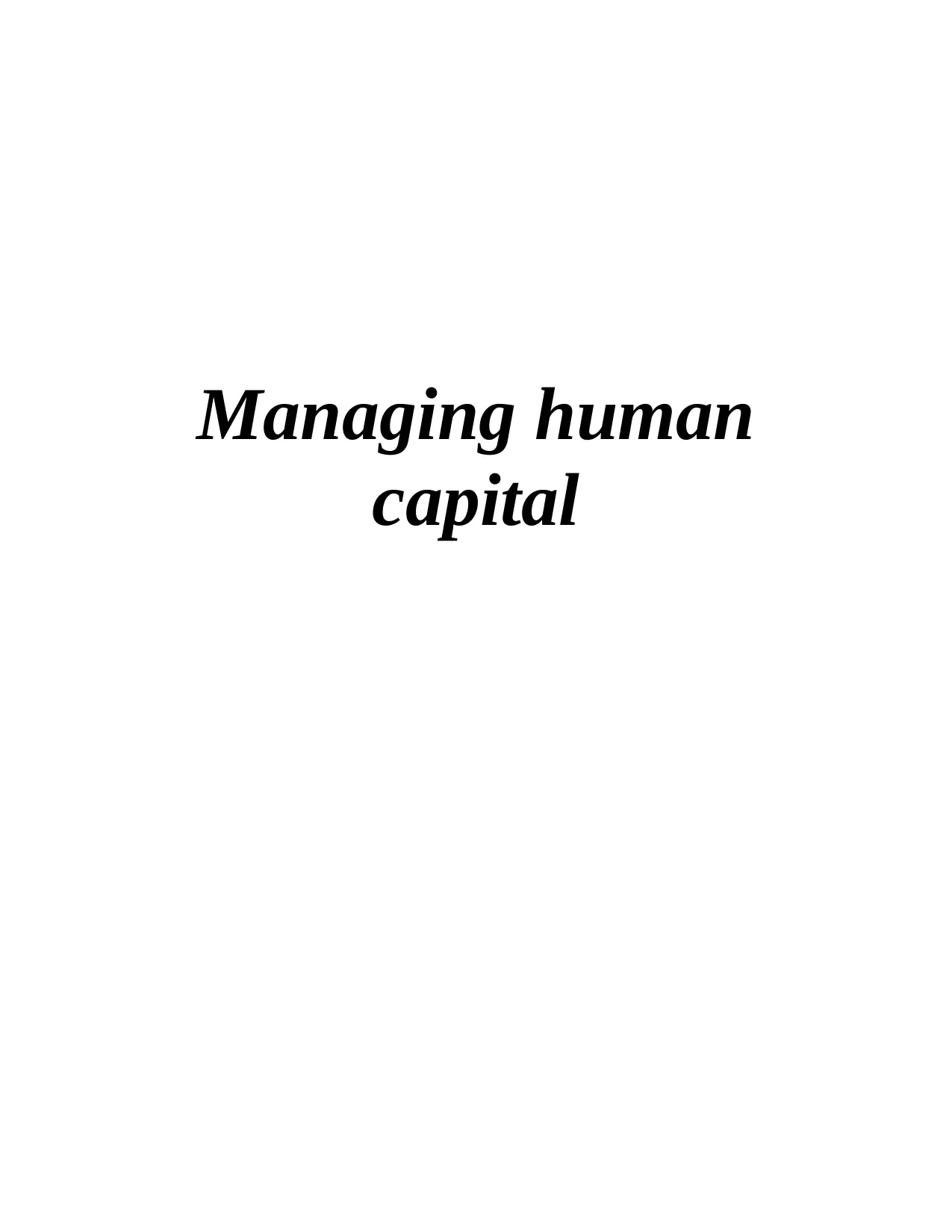
Managing human
capital
capital
Paraphrase This Document
Need a fresh take? Get an instant paraphrase of this document with our AI Paraphraser
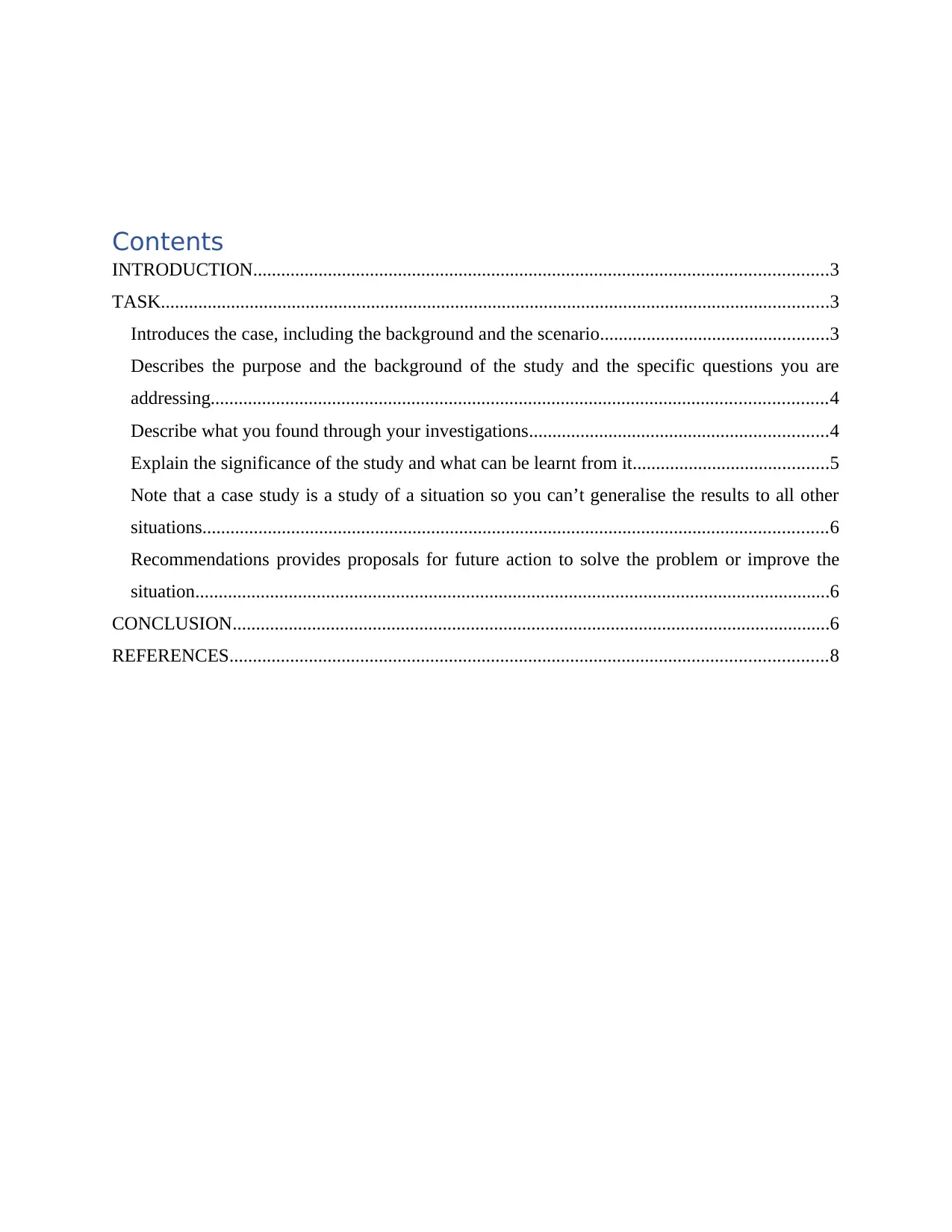
Contents
INTRODUCTION...........................................................................................................................3
TASK...............................................................................................................................................3
Introduces the case, including the background and the scenario.................................................3
Describes the purpose and the background of the study and the specific questions you are
addressing....................................................................................................................................4
Describe what you found through your investigations................................................................4
Explain the significance of the study and what can be learnt from it..........................................5
Note that a case study is a study of a situation so you can’t generalise the results to all other
situations......................................................................................................................................6
Recommendations provides proposals for future action to solve the problem or improve the
situation........................................................................................................................................6
CONCLUSION................................................................................................................................6
REFERENCES................................................................................................................................8
INTRODUCTION...........................................................................................................................3
TASK...............................................................................................................................................3
Introduces the case, including the background and the scenario.................................................3
Describes the purpose and the background of the study and the specific questions you are
addressing....................................................................................................................................4
Describe what you found through your investigations................................................................4
Explain the significance of the study and what can be learnt from it..........................................5
Note that a case study is a study of a situation so you can’t generalise the results to all other
situations......................................................................................................................................6
Recommendations provides proposals for future action to solve the problem or improve the
situation........................................................................................................................................6
CONCLUSION................................................................................................................................6
REFERENCES................................................................................................................................8
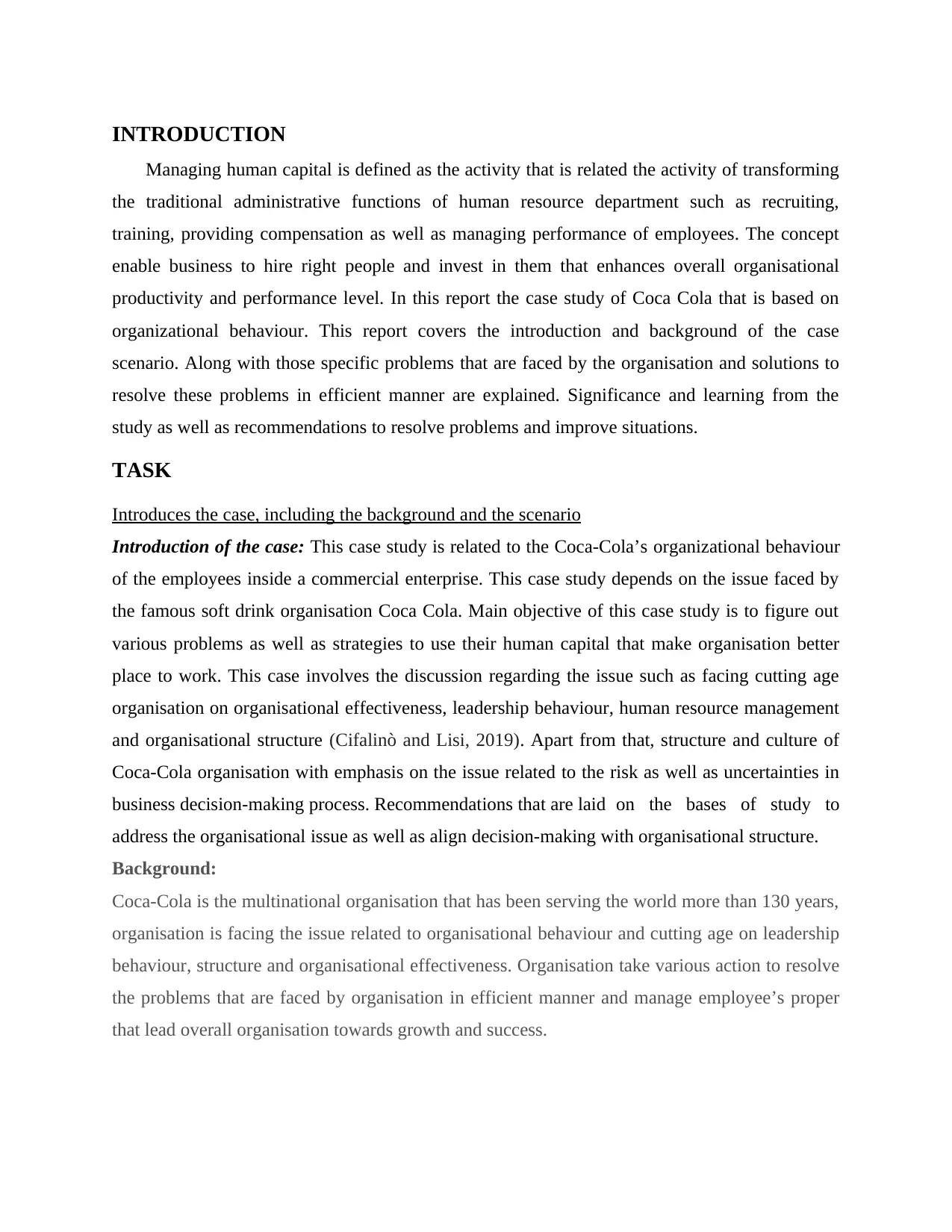
INTRODUCTION
Managing human capital is defined as the activity that is related the activity of transforming
the traditional administrative functions of human resource department such as recruiting,
training, providing compensation as well as managing performance of employees. The concept
enable business to hire right people and invest in them that enhances overall organisational
productivity and performance level. In this report the case study of Coca Cola that is based on
organizational behaviour. This report covers the introduction and background of the case
scenario. Along with those specific problems that are faced by the organisation and solutions to
resolve these problems in efficient manner are explained. Significance and learning from the
study as well as recommendations to resolve problems and improve situations.
TASK
Introduces the case, including the background and the scenario
Introduction of the case: This case study is related to the Coca-Cola’s organizational behaviour
of the employees inside a commercial enterprise. This case study depends on the issue faced by
the famous soft drink organisation Coca Cola. Main objective of this case study is to figure out
various problems as well as strategies to use their human capital that make organisation better
place to work. This case involves the discussion regarding the issue such as facing cutting age
organisation on organisational effectiveness, leadership behaviour, human resource management
and organisational structure (Cifalinò and Lisi, 2019). Apart from that, structure and culture of
Coca-Cola organisation with emphasis on the issue related to the risk as well as uncertainties in
business decision-making process. Recommendations that are laid on the bases of study to
address the organisational issue as well as align decision-making with organisational structure.
Background:
Coca-Cola is the multinational organisation that has been serving the world more than 130 years,
organisation is facing the issue related to organisational behaviour and cutting age on leadership
behaviour, structure and organisational effectiveness. Organisation take various action to resolve
the problems that are faced by organisation in efficient manner and manage employee’s proper
that lead overall organisation towards growth and success.
Managing human capital is defined as the activity that is related the activity of transforming
the traditional administrative functions of human resource department such as recruiting,
training, providing compensation as well as managing performance of employees. The concept
enable business to hire right people and invest in them that enhances overall organisational
productivity and performance level. In this report the case study of Coca Cola that is based on
organizational behaviour. This report covers the introduction and background of the case
scenario. Along with those specific problems that are faced by the organisation and solutions to
resolve these problems in efficient manner are explained. Significance and learning from the
study as well as recommendations to resolve problems and improve situations.
TASK
Introduces the case, including the background and the scenario
Introduction of the case: This case study is related to the Coca-Cola’s organizational behaviour
of the employees inside a commercial enterprise. This case study depends on the issue faced by
the famous soft drink organisation Coca Cola. Main objective of this case study is to figure out
various problems as well as strategies to use their human capital that make organisation better
place to work. This case involves the discussion regarding the issue such as facing cutting age
organisation on organisational effectiveness, leadership behaviour, human resource management
and organisational structure (Cifalinò and Lisi, 2019). Apart from that, structure and culture of
Coca-Cola organisation with emphasis on the issue related to the risk as well as uncertainties in
business decision-making process. Recommendations that are laid on the bases of study to
address the organisational issue as well as align decision-making with organisational structure.
Background:
Coca-Cola is the multinational organisation that has been serving the world more than 130 years,
organisation is facing the issue related to organisational behaviour and cutting age on leadership
behaviour, structure and organisational effectiveness. Organisation take various action to resolve
the problems that are faced by organisation in efficient manner and manage employee’s proper
that lead overall organisation towards growth and success.
⊘ This is a preview!⊘
Do you want full access?
Subscribe today to unlock all pages.

Trusted by 1+ million students worldwide
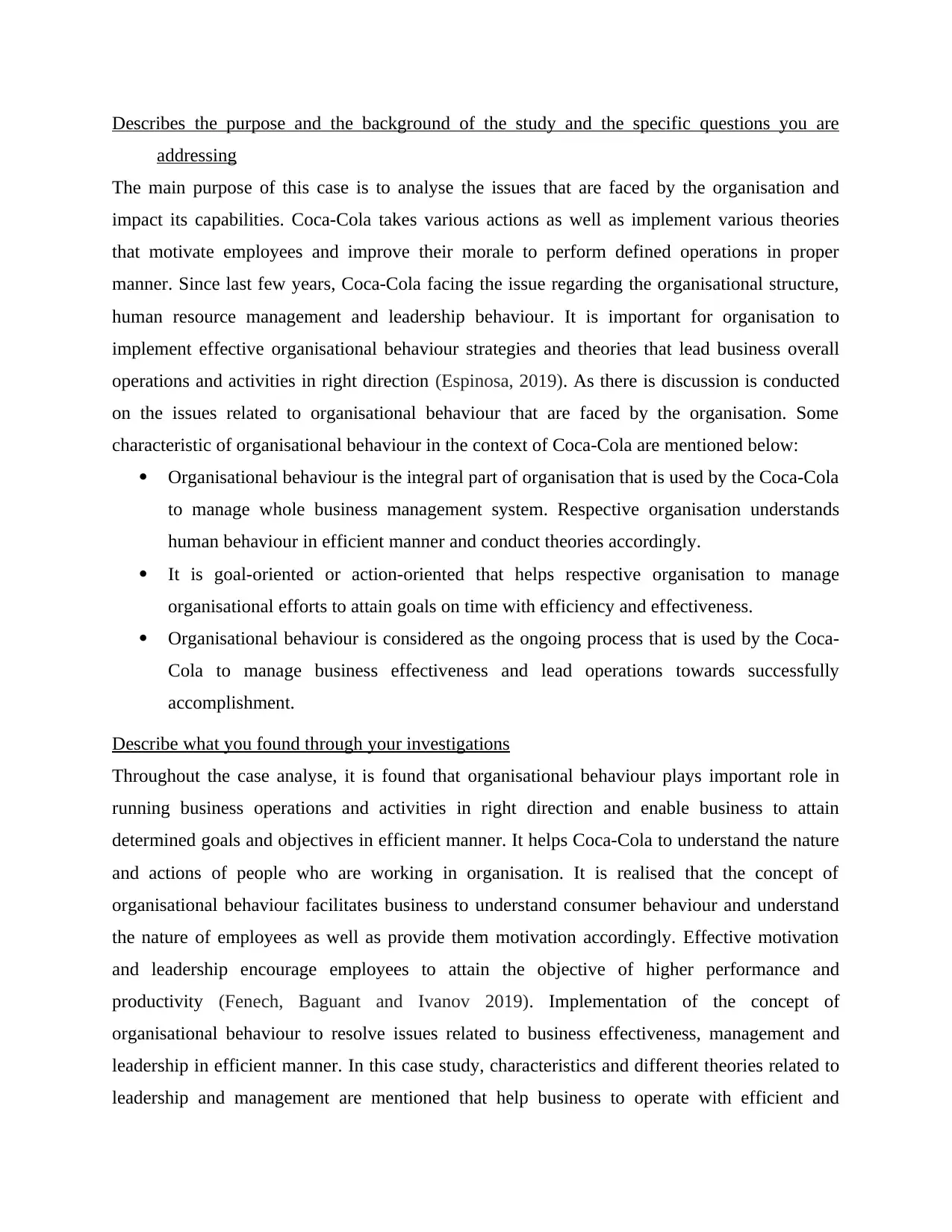
Describes the purpose and the background of the study and the specific questions you are
addressing
The main purpose of this case is to analyse the issues that are faced by the organisation and
impact its capabilities. Coca-Cola takes various actions as well as implement various theories
that motivate employees and improve their morale to perform defined operations in proper
manner. Since last few years, Coca-Cola facing the issue regarding the organisational structure,
human resource management and leadership behaviour. It is important for organisation to
implement effective organisational behaviour strategies and theories that lead business overall
operations and activities in right direction (Espinosa, 2019). As there is discussion is conducted
on the issues related to organisational behaviour that are faced by the organisation. Some
characteristic of organisational behaviour in the context of Coca-Cola are mentioned below:
Organisational behaviour is the integral part of organisation that is used by the Coca-Cola
to manage whole business management system. Respective organisation understands
human behaviour in efficient manner and conduct theories accordingly.
It is goal-oriented or action-oriented that helps respective organisation to manage
organisational efforts to attain goals on time with efficiency and effectiveness.
Organisational behaviour is considered as the ongoing process that is used by the Coca-
Cola to manage business effectiveness and lead operations towards successfully
accomplishment.
Describe what you found through your investigations
Throughout the case analyse, it is found that organisational behaviour plays important role in
running business operations and activities in right direction and enable business to attain
determined goals and objectives in efficient manner. It helps Coca-Cola to understand the nature
and actions of people who are working in organisation. It is realised that the concept of
organisational behaviour facilitates business to understand consumer behaviour and understand
the nature of employees as well as provide them motivation accordingly. Effective motivation
and leadership encourage employees to attain the objective of higher performance and
productivity (Fenech, Baguant and Ivanov 2019). Implementation of the concept of
organisational behaviour to resolve issues related to business effectiveness, management and
leadership in efficient manner. In this case study, characteristics and different theories related to
leadership and management are mentioned that help business to operate with efficient and
addressing
The main purpose of this case is to analyse the issues that are faced by the organisation and
impact its capabilities. Coca-Cola takes various actions as well as implement various theories
that motivate employees and improve their morale to perform defined operations in proper
manner. Since last few years, Coca-Cola facing the issue regarding the organisational structure,
human resource management and leadership behaviour. It is important for organisation to
implement effective organisational behaviour strategies and theories that lead business overall
operations and activities in right direction (Espinosa, 2019). As there is discussion is conducted
on the issues related to organisational behaviour that are faced by the organisation. Some
characteristic of organisational behaviour in the context of Coca-Cola are mentioned below:
Organisational behaviour is the integral part of organisation that is used by the Coca-Cola
to manage whole business management system. Respective organisation understands
human behaviour in efficient manner and conduct theories accordingly.
It is goal-oriented or action-oriented that helps respective organisation to manage
organisational efforts to attain goals on time with efficiency and effectiveness.
Organisational behaviour is considered as the ongoing process that is used by the Coca-
Cola to manage business effectiveness and lead operations towards successfully
accomplishment.
Describe what you found through your investigations
Throughout the case analyse, it is found that organisational behaviour plays important role in
running business operations and activities in right direction and enable business to attain
determined goals and objectives in efficient manner. It helps Coca-Cola to understand the nature
and actions of people who are working in organisation. It is realised that the concept of
organisational behaviour facilitates business to understand consumer behaviour and understand
the nature of employees as well as provide them motivation accordingly. Effective motivation
and leadership encourage employees to attain the objective of higher performance and
productivity (Fenech, Baguant and Ivanov 2019). Implementation of the concept of
organisational behaviour to resolve issues related to business effectiveness, management and
leadership in efficient manner. In this case study, characteristics and different theories related to
leadership and management are mentioned that help business to operate with efficient and
Paraphrase This Document
Need a fresh take? Get an instant paraphrase of this document with our AI Paraphraser
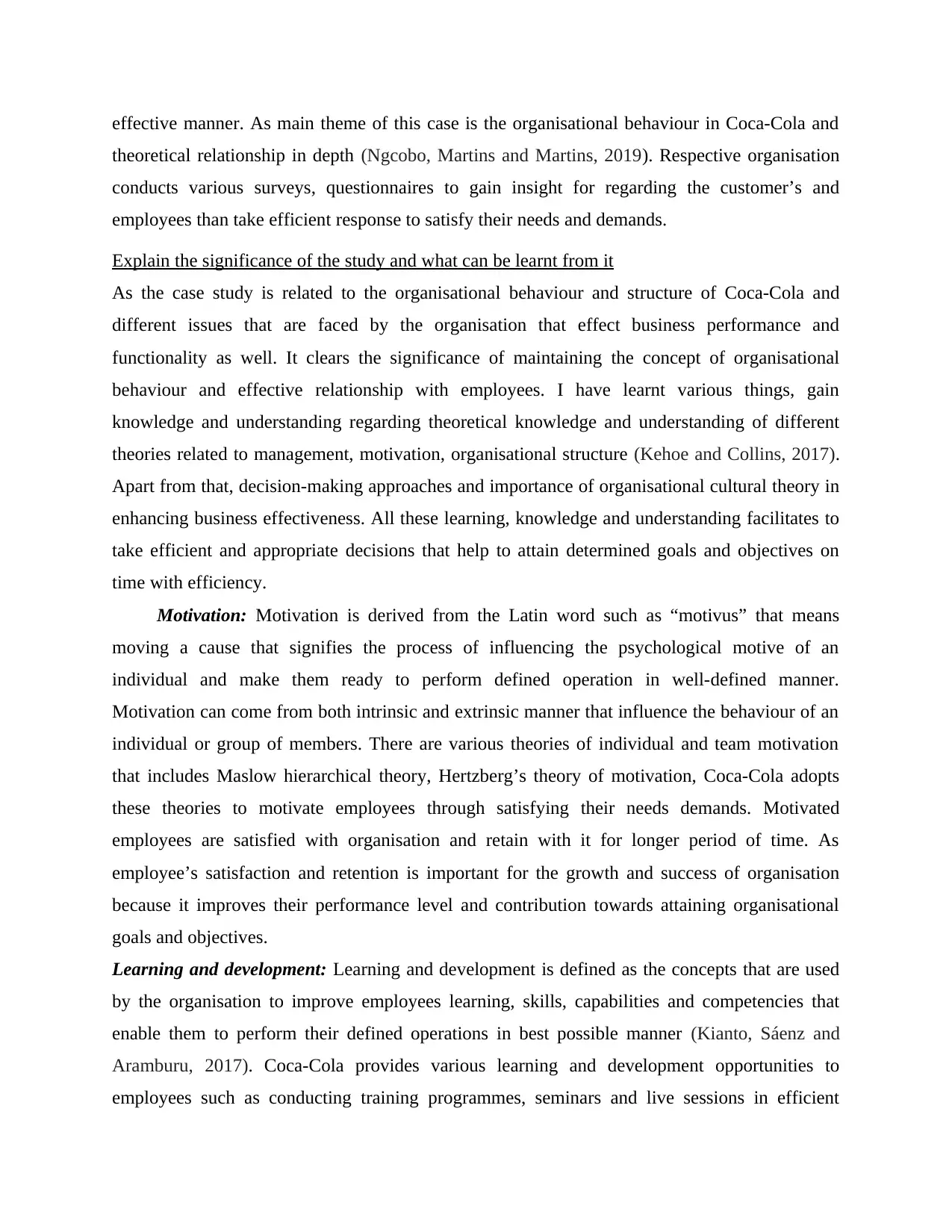
effective manner. As main theme of this case is the organisational behaviour in Coca-Cola and
theoretical relationship in depth (Ngcobo, Martins and Martins, 2019). Respective organisation
conducts various surveys, questionnaires to gain insight for regarding the customer’s and
employees than take efficient response to satisfy their needs and demands.
Explain the significance of the study and what can be learnt from it
As the case study is related to the organisational behaviour and structure of Coca-Cola and
different issues that are faced by the organisation that effect business performance and
functionality as well. It clears the significance of maintaining the concept of organisational
behaviour and effective relationship with employees. I have learnt various things, gain
knowledge and understanding regarding theoretical knowledge and understanding of different
theories related to management, motivation, organisational structure (Kehoe and Collins, 2017).
Apart from that, decision-making approaches and importance of organisational cultural theory in
enhancing business effectiveness. All these learning, knowledge and understanding facilitates to
take efficient and appropriate decisions that help to attain determined goals and objectives on
time with efficiency.
Motivation: Motivation is derived from the Latin word such as “motivus” that means
moving a cause that signifies the process of influencing the psychological motive of an
individual and make them ready to perform defined operation in well-defined manner.
Motivation can come from both intrinsic and extrinsic manner that influence the behaviour of an
individual or group of members. There are various theories of individual and team motivation
that includes Maslow hierarchical theory, Hertzberg’s theory of motivation, Coca-Cola adopts
these theories to motivate employees through satisfying their needs demands. Motivated
employees are satisfied with organisation and retain with it for longer period of time. As
employee’s satisfaction and retention is important for the growth and success of organisation
because it improves their performance level and contribution towards attaining organisational
goals and objectives.
Learning and development: Learning and development is defined as the concepts that are used
by the organisation to improve employees learning, skills, capabilities and competencies that
enable them to perform their defined operations in best possible manner (Kianto, Sáenz and
Aramburu, 2017). Coca-Cola provides various learning and development opportunities to
employees such as conducting training programmes, seminars and live sessions in efficient
theoretical relationship in depth (Ngcobo, Martins and Martins, 2019). Respective organisation
conducts various surveys, questionnaires to gain insight for regarding the customer’s and
employees than take efficient response to satisfy their needs and demands.
Explain the significance of the study and what can be learnt from it
As the case study is related to the organisational behaviour and structure of Coca-Cola and
different issues that are faced by the organisation that effect business performance and
functionality as well. It clears the significance of maintaining the concept of organisational
behaviour and effective relationship with employees. I have learnt various things, gain
knowledge and understanding regarding theoretical knowledge and understanding of different
theories related to management, motivation, organisational structure (Kehoe and Collins, 2017).
Apart from that, decision-making approaches and importance of organisational cultural theory in
enhancing business effectiveness. All these learning, knowledge and understanding facilitates to
take efficient and appropriate decisions that help to attain determined goals and objectives on
time with efficiency.
Motivation: Motivation is derived from the Latin word such as “motivus” that means
moving a cause that signifies the process of influencing the psychological motive of an
individual and make them ready to perform defined operation in well-defined manner.
Motivation can come from both intrinsic and extrinsic manner that influence the behaviour of an
individual or group of members. There are various theories of individual and team motivation
that includes Maslow hierarchical theory, Hertzberg’s theory of motivation, Coca-Cola adopts
these theories to motivate employees through satisfying their needs demands. Motivated
employees are satisfied with organisation and retain with it for longer period of time. As
employee’s satisfaction and retention is important for the growth and success of organisation
because it improves their performance level and contribution towards attaining organisational
goals and objectives.
Learning and development: Learning and development is defined as the concepts that are used
by the organisation to improve employees learning, skills, capabilities and competencies that
enable them to perform their defined operations in best possible manner (Kianto, Sáenz and
Aramburu, 2017). Coca-Cola provides various learning and development opportunities to
employees such as conducting training programmes, seminars and live sessions in efficient
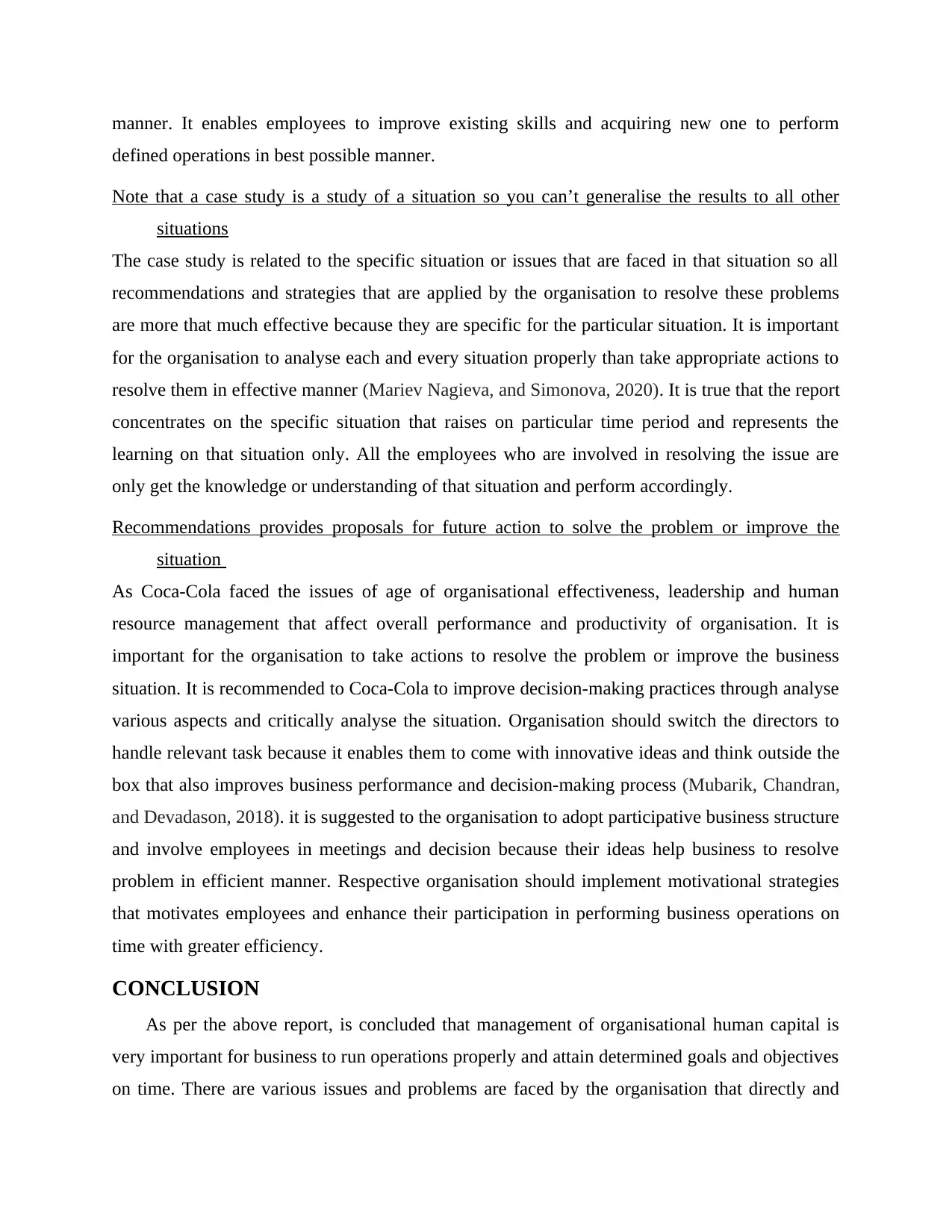
manner. It enables employees to improve existing skills and acquiring new one to perform
defined operations in best possible manner.
Note that a case study is a study of a situation so you can’t generalise the results to all other
situations
The case study is related to the specific situation or issues that are faced in that situation so all
recommendations and strategies that are applied by the organisation to resolve these problems
are more that much effective because they are specific for the particular situation. It is important
for the organisation to analyse each and every situation properly than take appropriate actions to
resolve them in effective manner (Mariev Nagieva, and Simonova, 2020). It is true that the report
concentrates on the specific situation that raises on particular time period and represents the
learning on that situation only. All the employees who are involved in resolving the issue are
only get the knowledge or understanding of that situation and perform accordingly.
Recommendations provides proposals for future action to solve the problem or improve the
situation
As Coca-Cola faced the issues of age of organisational effectiveness, leadership and human
resource management that affect overall performance and productivity of organisation. It is
important for the organisation to take actions to resolve the problem or improve the business
situation. It is recommended to Coca-Cola to improve decision-making practices through analyse
various aspects and critically analyse the situation. Organisation should switch the directors to
handle relevant task because it enables them to come with innovative ideas and think outside the
box that also improves business performance and decision-making process (Mubarik, Chandran,
and Devadason, 2018). it is suggested to the organisation to adopt participative business structure
and involve employees in meetings and decision because their ideas help business to resolve
problem in efficient manner. Respective organisation should implement motivational strategies
that motivates employees and enhance their participation in performing business operations on
time with greater efficiency.
CONCLUSION
As per the above report, is concluded that management of organisational human capital is
very important for business to run operations properly and attain determined goals and objectives
on time. There are various issues and problems are faced by the organisation that directly and
defined operations in best possible manner.
Note that a case study is a study of a situation so you can’t generalise the results to all other
situations
The case study is related to the specific situation or issues that are faced in that situation so all
recommendations and strategies that are applied by the organisation to resolve these problems
are more that much effective because they are specific for the particular situation. It is important
for the organisation to analyse each and every situation properly than take appropriate actions to
resolve them in effective manner (Mariev Nagieva, and Simonova, 2020). It is true that the report
concentrates on the specific situation that raises on particular time period and represents the
learning on that situation only. All the employees who are involved in resolving the issue are
only get the knowledge or understanding of that situation and perform accordingly.
Recommendations provides proposals for future action to solve the problem or improve the
situation
As Coca-Cola faced the issues of age of organisational effectiveness, leadership and human
resource management that affect overall performance and productivity of organisation. It is
important for the organisation to take actions to resolve the problem or improve the business
situation. It is recommended to Coca-Cola to improve decision-making practices through analyse
various aspects and critically analyse the situation. Organisation should switch the directors to
handle relevant task because it enables them to come with innovative ideas and think outside the
box that also improves business performance and decision-making process (Mubarik, Chandran,
and Devadason, 2018). it is suggested to the organisation to adopt participative business structure
and involve employees in meetings and decision because their ideas help business to resolve
problem in efficient manner. Respective organisation should implement motivational strategies
that motivates employees and enhance their participation in performing business operations on
time with greater efficiency.
CONCLUSION
As per the above report, is concluded that management of organisational human capital is
very important for business to run operations properly and attain determined goals and objectives
on time. There are various issues and problems are faced by the organisation that directly and
⊘ This is a preview!⊘
Do you want full access?
Subscribe today to unlock all pages.

Trusted by 1+ million students worldwide
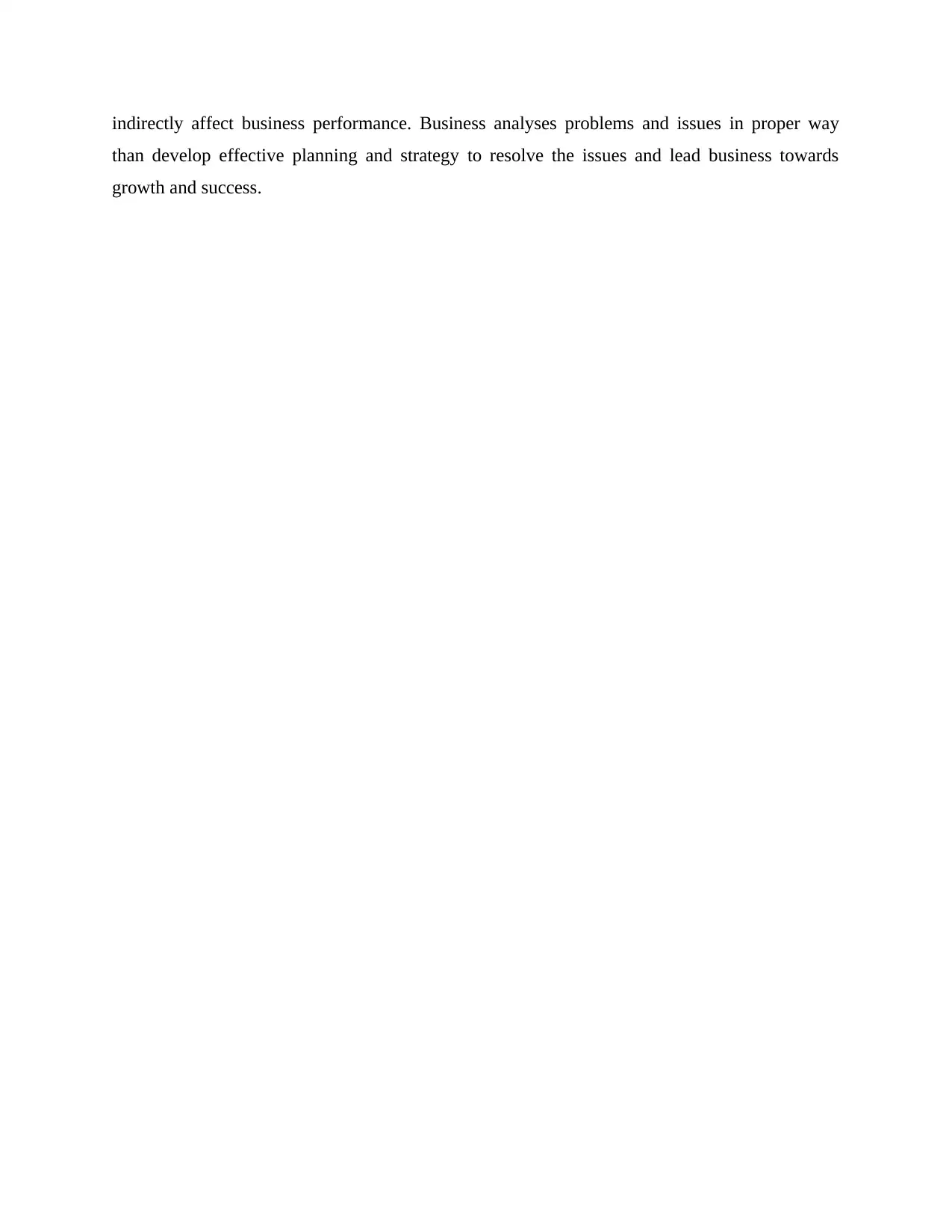
indirectly affect business performance. Business analyses problems and issues in proper way
than develop effective planning and strategy to resolve the issues and lead business towards
growth and success.
than develop effective planning and strategy to resolve the issues and lead business towards
growth and success.
Paraphrase This Document
Need a fresh take? Get an instant paraphrase of this document with our AI Paraphraser
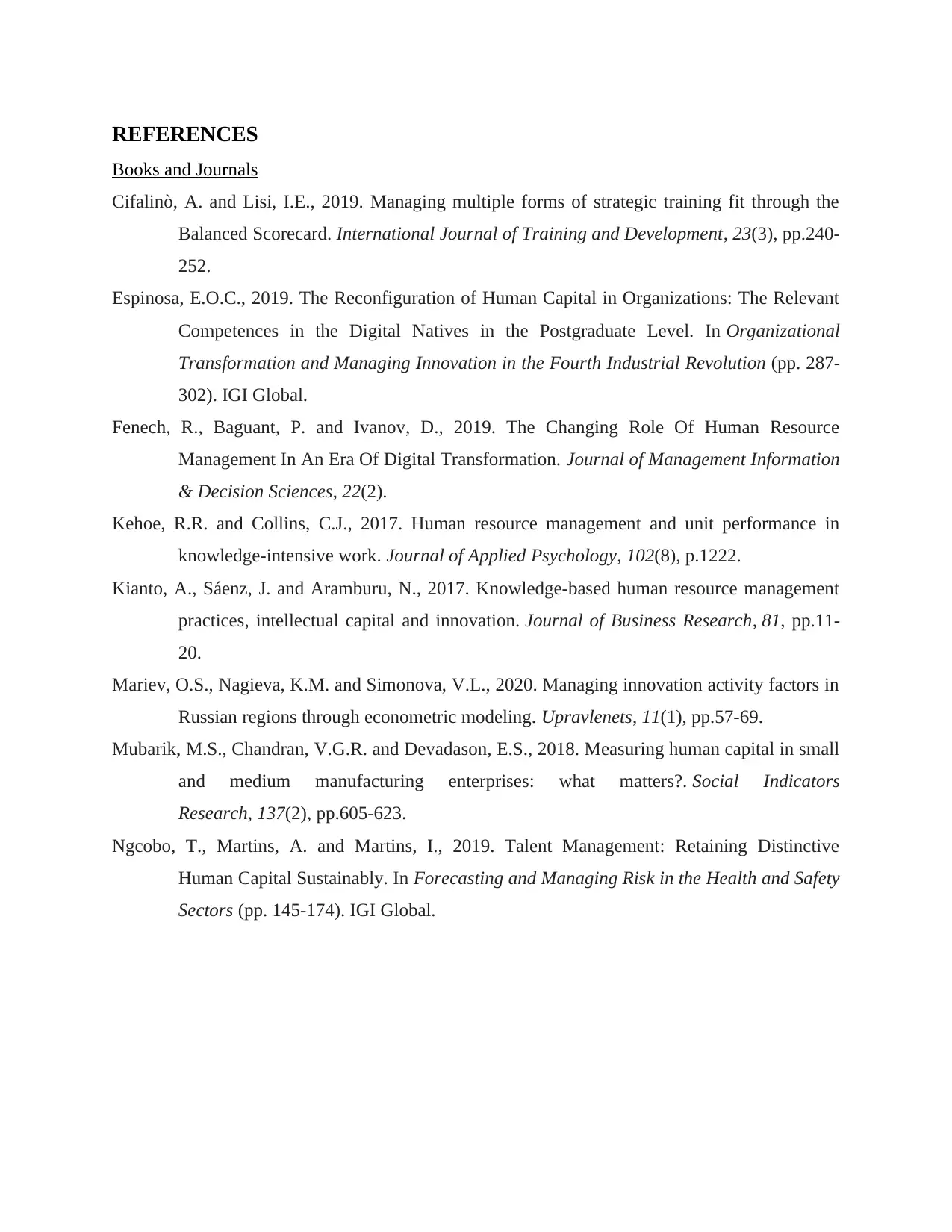
REFERENCES
Books and Journals
Cifalinò, A. and Lisi, I.E., 2019. Managing multiple forms of strategic training fit through the
Balanced Scorecard. International Journal of Training and Development, 23(3), pp.240-
252.
Espinosa, E.O.C., 2019. The Reconfiguration of Human Capital in Organizations: The Relevant
Competences in the Digital Natives in the Postgraduate Level. In Organizational
Transformation and Managing Innovation in the Fourth Industrial Revolution (pp. 287-
302). IGI Global.
Fenech, R., Baguant, P. and Ivanov, D., 2019. The Changing Role Of Human Resource
Management In An Era Of Digital Transformation. Journal of Management Information
& Decision Sciences, 22(2).
Kehoe, R.R. and Collins, C.J., 2017. Human resource management and unit performance in
knowledge-intensive work. Journal of Applied Psychology, 102(8), p.1222.
Kianto, A., Sáenz, J. and Aramburu, N., 2017. Knowledge-based human resource management
practices, intellectual capital and innovation. Journal of Business Research, 81, pp.11-
20.
Mariev, O.S., Nagieva, K.M. and Simonova, V.L., 2020. Managing innovation activity factors in
Russian regions through econometric modeling. Upravlenets, 11(1), pp.57-69.
Mubarik, M.S., Chandran, V.G.R. and Devadason, E.S., 2018. Measuring human capital in small
and medium manufacturing enterprises: what matters?. Social Indicators
Research, 137(2), pp.605-623.
Ngcobo, T., Martins, A. and Martins, I., 2019. Talent Management: Retaining Distinctive
Human Capital Sustainably. In Forecasting and Managing Risk in the Health and Safety
Sectors (pp. 145-174). IGI Global.
Books and Journals
Cifalinò, A. and Lisi, I.E., 2019. Managing multiple forms of strategic training fit through the
Balanced Scorecard. International Journal of Training and Development, 23(3), pp.240-
252.
Espinosa, E.O.C., 2019. The Reconfiguration of Human Capital in Organizations: The Relevant
Competences in the Digital Natives in the Postgraduate Level. In Organizational
Transformation and Managing Innovation in the Fourth Industrial Revolution (pp. 287-
302). IGI Global.
Fenech, R., Baguant, P. and Ivanov, D., 2019. The Changing Role Of Human Resource
Management In An Era Of Digital Transformation. Journal of Management Information
& Decision Sciences, 22(2).
Kehoe, R.R. and Collins, C.J., 2017. Human resource management and unit performance in
knowledge-intensive work. Journal of Applied Psychology, 102(8), p.1222.
Kianto, A., Sáenz, J. and Aramburu, N., 2017. Knowledge-based human resource management
practices, intellectual capital and innovation. Journal of Business Research, 81, pp.11-
20.
Mariev, O.S., Nagieva, K.M. and Simonova, V.L., 2020. Managing innovation activity factors in
Russian regions through econometric modeling. Upravlenets, 11(1), pp.57-69.
Mubarik, M.S., Chandran, V.G.R. and Devadason, E.S., 2018. Measuring human capital in small
and medium manufacturing enterprises: what matters?. Social Indicators
Research, 137(2), pp.605-623.
Ngcobo, T., Martins, A. and Martins, I., 2019. Talent Management: Retaining Distinctive
Human Capital Sustainably. In Forecasting and Managing Risk in the Health and Safety
Sectors (pp. 145-174). IGI Global.

⊘ This is a preview!⊘
Do you want full access?
Subscribe today to unlock all pages.

Trusted by 1+ million students worldwide

1 out of 10
Related Documents
Your All-in-One AI-Powered Toolkit for Academic Success.
+13062052269
info@desklib.com
Available 24*7 on WhatsApp / Email
![[object Object]](/_next/static/media/star-bottom.7253800d.svg)
Unlock your academic potential
Copyright © 2020–2025 A2Z Services. All Rights Reserved. Developed and managed by ZUCOL.





